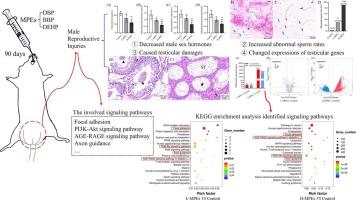三种邻苯二甲酸盐混合物致大鼠雄性生殖损伤机制的转录组学分析。
IF 3.4
3区 医学
Q2 PHARMACOLOGY & PHARMACY
引用次数: 0
摘要
邻苯二甲酸酯(PEs)在环境中广泛存在,人类不可避免地暴露于PEs的混合物中,可能引发男性生殖健康风险。为了探讨邻苯二甲酸二-2-乙基己酯、邻苯二甲酸二丁酯和邻苯二甲酸丁苄酯(MPEs)混合物对雄性生殖损伤的机制,采用16 mg/kg/d MPEs (L-MPEs)和450 mg/kg/d MPEs (H-MPEs)口服90 d,结果表明MPEs降低睾丸、附睾和附睾周围脂肪的重量,降低血清雄性激素水平,增加异常精子率,并引起睾丸组织病理损伤。如精小管萎缩空化、精细胞脱落、间质细胞增生、睾丸间质脂滴积聚等。睾丸转录组学分析发现,L-MPEs组有100个差异表达基因(DEGs), H-MPEs组有10880个差异表达基因(DEGs),这些差异表达基因主要参与局灶黏附、PI3K-Akt、AGE-RAGE、轴索引导、PPAR、MAPK等信号通路。MPEs处理组睾丸Paxillin和vinculin显著上调,初步证实局灶性粘连是MPEs致男性生殖损伤的途径之一。本研究为进一步研究MPEs的雄性生殖毒性机制提供了新的思路。本文章由计算机程序翻译,如有差异,请以英文原文为准。

Transcriptomic analysis of the mechanism of male reproductive injuries caused by the mixture of three phthalates in rats
Phthalates (PEs) are widespread in environment, and human beings are unavoidably exposing to the mixture of PEs, which may induce male reproductive health risks. In order to investigate the mechanism of male reproductive injuries caused by the mixture of di-2-ethylhexyl phthalate, dibutyl phthalate and butyl benzyl phthalate (MPEs), male rats were orally exposed to 16 mg/kg/d MPEs (L-MPEs) and 450 mg/kg/d MPEs (H-MPEs) for 90 days, and the results showed that MPEs decreased the weights of testes, epididymis and periepididymis fat, decreased serum levels of male hormones, increased abnormal sperm rate, and caused testicular histopathological damages, such as atrophy and cavitation of seminiferous tubules, spermatids exfoliation, Leydig cells hyperplasia and accumulation of lipid droplets in the testicular interstitium. Testicular transcriptomic analysis identified 100 differently expressed genes (DEGs) in L-MPEs group and 10,880 DEGs in H-MPEs group, and these DEGs mainly involved in signaling pathways of focal adhesion, PI3K-Akt, AGE-RAGE, axon guidance, PPAR, MAPK and etc. Testicular Paxillin and vinculin were significantly upregulated in MPEs treated groups, initially verified that focal adhesion was a pathway of male reproductive injuries induced by MPEs. This study provides new ideas for the further researches on the mechanism of MPEs' male reproductive toxicity.
求助全文
通过发布文献求助,成功后即可免费获取论文全文。
去求助
来源期刊
CiteScore
6.80
自引率
2.60%
发文量
309
审稿时长
32 days
期刊介绍:
Toxicology and Applied Pharmacology publishes original scientific research of relevance to animals or humans pertaining to the action of chemicals, drugs, or chemically-defined natural products.
Regular articles address mechanistic approaches to physiological, pharmacologic, biochemical, cellular, or molecular understanding of toxicologic/pathologic lesions and to methods used to describe these responses. Safety Science articles address outstanding state-of-the-art preclinical and human translational characterization of drug and chemical safety employing cutting-edge science. Highly significant Regulatory Safety Science articles will also be considered in this category. Papers concerned with alternatives to the use of experimental animals are encouraged.
Short articles report on high impact studies of broad interest to readers of TAAP that would benefit from rapid publication. These articles should contain no more than a combined total of four figures and tables. Authors should include in their cover letter the justification for consideration of their manuscript as a short article.

 求助内容:
求助内容: 应助结果提醒方式:
应助结果提醒方式:


